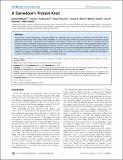| dc.contributor.author | Bölinger, Daniel | |
| dc.contributor.author | Sułkowska, Joanna I. | |
| dc.contributor.author | Hsu, Hsiao-Ping | |
| dc.contributor.author | Mirny, Leonid A. | |
| dc.contributor.author | Kardar, Mehran | |
| dc.contributor.author | Onuchic, José N. | |
| dc.contributor.author | Virnau, Peter | |
| dc.date.accessioned | 2010-08-27T13:53:34Z | |
| dc.date.available | 2010-08-27T13:53:34Z | |
| dc.date.issued | 2010-04 | |
| dc.date.submitted | 2009-06 | |
| dc.identifier.issn | 1553-734X | |
| dc.identifier.issn | 1553-7358 | |
| dc.identifier.uri | http://hdl.handle.net/1721.1/57578 | |
| dc.description.abstract | Protein knots, mostly regarded as intriguing oddities, are gradually being recognized as significant structural motifs. Seven distinctly knotted folds have already been identified. It is by and large unclear how these exceptional structures actually fold, and only recently, experiments and simulations have begun to shed some light on this issue. In checking the new protein structures submitted to the Protein Data Bank, we encountered the most complex and the smallest knots to date: A recently uncovered α-haloacid dehalogenase structure contains a knot with six crossings, a so-called Stevedore knot, in a projection onto a plane. The smallest protein knot is present in an as yet unclassified protein fragment that consists of only 92 amino acids. The topological complexity of the Stevedore knot presents a puzzle as to how it could possibly fold. To unravel this enigma, we performed folding simulations with a structure-based coarse-grained model and uncovered a possible mechanism by which the knot forms in a single loop flip. | en_US |
| dc.language.iso | en_US | |
| dc.publisher | Public Library of Science | en_US |
| dc.relation.isversionof | http://dx.doi.org/10.1371/journal.pcbi.1000731 | en_US |
| dc.rights | Creative Commons Attribution | en_US |
| dc.rights.uri | http://creativecommons.org/licenses/by/2.5/ | en_US |
| dc.source | PLoS | en_US |
| dc.title | A Stevedore's Protein Knot | en_US |
| dc.type | Article | en_US |
| dc.identifier.citation | Bölinger, Daniel et al. “A Stevedore's Protein Knot.” PLoS Comput Biol 6.4 (2010): e1000731. | en_US |
| dc.contributor.department | Harvard University--MIT Division of Health Sciences and Technology | en_US |
| dc.contributor.department | Massachusetts Institute of Technology. Department of Physics | en_US |
| dc.contributor.approver | Kardar, Mehran | |
| dc.contributor.mitauthor | Mirny, Leonid A. | |
| dc.contributor.mitauthor | Kardar, Mehran | |
| dc.relation.journal | PLoS Computational Biology | en_US |
| dc.eprint.version | Final published version | en_US |
| dc.type.uri | http://purl.org/eprint/type/JournalArticle | en_US |
| eprint.status | http://purl.org/eprint/status/PeerReviewed | en_US |
| dspace.orderedauthors | Bölinger, Daniel; Sułkowska, Joanna I.; Hsu, Hsiao-Ping; Mirny, Leonid A.; Kardar, Mehran; Onuchic, José N.; Virnau, Peter | en |
| dc.identifier.orcid | https://orcid.org/0000-0002-0785-5410 | |
| dc.identifier.orcid | https://orcid.org/0000-0002-1112-5912 | |
| mit.license | PUBLISHER_CC | en_US |
| mit.metadata.status | Complete | |
